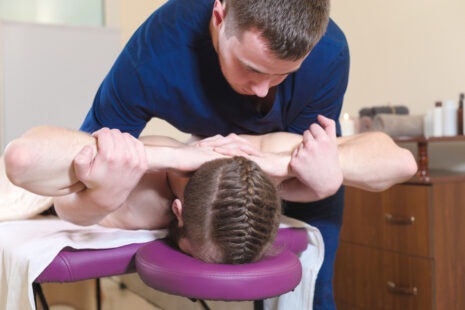Rotator cuff problems are common, affecting a wide range of individuals, especially those who perform repetitive arm movements or engage in sports. Two prevalent conditions are rotator cuff tendonitis (also known as tendinopathy) and rotator cuff tears. While both affect the same area, their implications, treatment, and recovery can differ significantly. Understanding the differences between them is crucial for seeking appropriate care.
Symptoms – Tendonitis vs. Tear
Rotator Cuff Tendonitis
- Pain – Often described as a dull ache deep in the shoulder.
- Activity-Related Discomfort – Pain typically worsens with certain activities, especially overhead movements.
- Night Pain – Discomfort might intensify when lying on the affected shoulder.
- Gradual Onset – Symptoms usually develop over time due to repetitive stress.
Rotator Cuff Tear
- Sudden, Sharp Pain – In the case of acute tears, pain may be immediate and severe.
- Weakness – Noticeable weakness when lifting the arm or performing specific movements.
- Limited Range of Motion – Difficulty or inability to reach behind the back or lift the arm overhead.
- Audible Symptoms – Some individuals report hearing a snapping sound at the time of injury.
Causes and Risk Factors
- Rotator Cuff Tendonitis – Often results from the overuse of the shoulder. Activities that require lifting the arms repeatedly or overhead sports (like baseball or tennis) can contribute to tendonitis. Aging is also a risk factor as blood supply to tendons decreases, making them more prone to injury.
- Rotator Cuff Tear – This can occur due to an acute injury (falling on an outstretched arm or lifting something very heavy) or through wear and tear over time. Degenerative tears are more common in older populations.
Diagnostic Methods
- Clinical Examination – A healthcare provider will perform a physical examination, assessing pain, strength, and range of motion. Specific tests can help differentiate between tendonitis and a tear.
- Imaging Tests
- X-rays can rule out other causes of shoulder pain but cannot show soft tissues like tendons.
- MRI (Magnetic Resonance Imaging) – The most effective way to view soft tissues, including the extent of tendonitis or identifying a tear.
- Ultrasound – Can also show tears in the rotator cuff tendons and assess the condition of the shoulder muscles.
Treatment and Management
- Rotator Cuff Tendonitis – Often managed with rest, ice, physical therapy, and anti-inflammatory medications. In some cases, corticosteroid injections are used to reduce inflammation.
- Rotator Cuff Tear – Treatment can range from physical therapy to strengthen surrounding muscles and compensate for the tear, to surgical repair for more significant or complete tears, depending on the severity and the individual’s activity level.
While rotator cuff tendonitis and tears share some similarities, key differences in their symptoms, causes, and diagnostic findings help differentiate them. Accurate diagnosis is vital for effective treatment. If you suspect you have a rotator cuff issue, consult a healthcare provider for a comprehensive evaluation to determine the specific nature of your condition and the most appropriate treatment plan.




